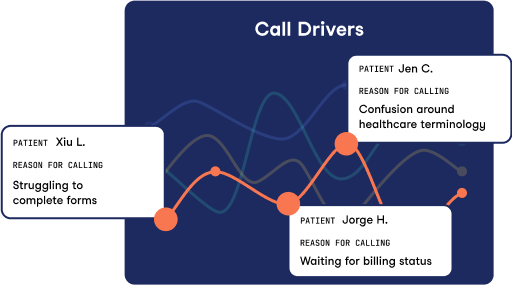Improve operations with feedback and data
Reduce healthcare costs to identify leading drivers of claim denials, rebilling, self-pay errors, and more with innovative technology like AI and machine learning.
Learn more about revenue cycle
Learn how artificial intelligence is unlocking insights across healthcare. Debunk 5 common myths associated with AI.

The Immense Power of Listening to the Voice of the Customer
Leveraging Authenticx AI, a global life sciences marketing team received insights about emerging conversational themes – Frustration, Cost, Access, and the Eddy Effect.
What are Three Ways to Reduce Health Care Costs
Healthcare costs have been rising at an unsustainable rate across the board, negatively impacting individuals, families, and society as a whole. Governments and healthcare institutions are responding to rising costs by implementing new measures to regulate prices and ensure patients get access to the care they need. So, one might question, what are three ways to reduce health care costs?
So why should we lower healthcare costs? Put simply, high healthcare costs have far-reaching consequences, from hindering access to essential services to causing financial strain on households and crippling the economy at large. Most devastatingly, high healthcare costs invariably lead to delayed or forgone care, especially among people with lower incomes or those without insurance.
And the benefits of reducing health care costs extend far beyond individual patients. From a societal perspective, lower healthcare costs can alleviate the burden on public health expenditure, allowing funds to be redirected towards other critical sectors such as education and infrastructure. Businesses could afford to provide better healthcare benefits to their employees, leading to increased job satisfaction.
With all that being said, what are three ways to reduce health care costs? Firstly, it’s important to prioritize preventive care. By detecting health issues at an early stage, patients can avoid the costs associated with treating advanced diseases. Improving transparency in healthcare pricing can also empower consumers to make more informed decisions. Finally, integrating and coordinating care can eliminate redundant services, cutting unnecessary expenses.
Embracing technology is among the more innovative ways to reduce healthcare costs. Advanced tech like AI has the potential to revolutionize the sector. Telemedicine, for example, can reduce overhead costs and improve access to care, particularly for individuals in remote locations.
Still, the mounting effects of rising healthcare costs continue to loom. The economic burden is undeniably massive, but the human toll is even more alarming. Rising costs have led to a decrease in the utilization of necessary health services, particularly among disadvantaged populations. The ripple effect of this phenomenon is profound, with potential long-term impacts on societal health and productivity.
Preventative Care and Early Prevention
Preventative care and early prevention are vital to lowering healthcare costs. Preventative care aims to prevent illnesses or injuries rather than curing them or treating their symptoms. Early prevention, by contrast, involves detecting and managing health issues before they escalate into more severe conditions requiring extensive intervention.
The importance of preventative care is underscored by the old adage, “An ounce of prevention is worth a pound of cure.” The healthcare system traditionally operates on a treatment model, where we seek help when sick. However, shifting the focus toward preventative care offers an effective strategy for health management.
Early prevention plays a similarly crucial role in reducing healthcare costs. Early detection of diseases, particularly chronic conditions such as heart disease, diabetes, and cancer, allows for more effective and less expensive treatment. It also boosts survival rates and improves the quality of life for affected individuals.
What are three ways to reduce health care costs utilizing preventative care and early prevention strategies? One of the best methods is implementing comprehensive preventive care programs that include regular health screenings and check-ups. These healthcare prevention programs allow for early detection of health problems, which can be managed or cured more cost-effectively than if caught later.
Second, public health initiatives designed to promote a healthy lifestyle can significantly reduce healthcare costs. These might include campaigns to encourage regular exercise, balanced nutrition, smoking cessation, and moderation in alcohol consumption. By preventing the onset of chronic diseases, these initiatives can lead to substantial savings in healthcare expenditure.
Third, the use of vaccinations can prevent a myriad of diseases, reducing the need for treatment and the associated costs. By investing in immunization programs, the healthcare system can avoid the high costs linked to treating vaccine-preventable diseases.
Patient Engagement in Healthcare
A growing number of healthcare providers are coming to realize the importance of patient engagement and transparency in delivering high-quality, cost-effective care. Patient engagement in healthcare describes the process of involving patients in their own healthcare decisions, including shared decision-making, self-care, and management of chronic conditions.
Healthcare transparency involves open communication about healthcare costs, quality, and other aspects of care. Some of the ways providers can boost engagement and increase transparency include:
- Reducing Readmissions: Engaged patients who understand their treatment plans and participate in their care decisions are less likely to be readmitted to the hospital, reducing costs to providers.
- Decreasing Unnecessary Testing: Engaged patients who understand their conditions and care options are less likely to demand unnecessary tests or treatments, leading to lower costs. With healthcare transparency, patients can make more informed decisions and eliminate unnecessary expenses.
- Improving Medication Adherence: When patients are engaged, they’re more likely to adhere to their medication regimens, reducing the risk of complications that could lead to costly hospital admissions or expensive interventions.
- Preventing Avoidable ER Visits: Patient engagement programs that include education about when to seek emergency care can reduce unnecessary ER visits, one of the most significant cost drivers in healthcare.
- Facilitating Chronic Disease Management: Chronic diseases require ongoing management to prevent complications and disease progression, which can be costly. By engaging patients in their care, providers can help them better manage their conditions and reduce these costs.
- Promoting Patient Satisfaction and Loyalty: Increased customer engagement can lead to higher patient satisfaction, improving patient retention and reducing the costs associated with acquiring new patients.
Patient engagement and transparency are clearly a win-win strategy that aligns the interests of patients and providers alike. This ultimately contributes to a more effective and efficient healthcare system.
How It Works
Gain a deeper level understanding of contact center conversations with AI solutions.
See a PreviewAggregate
Pull customer interaction data across vendors, products, and services into a single source of truth.
Analyze
Collect quantitative and qualitative information to understand patterns and uncover opportunities.

Activate
Confidently take action with insights that close the gap between your organization and your customers.
Health Information Technology
The healthcare industry is at the cusp of a technological revolution. At the heart of this transformation is health information technology (HIT), which is emerging as a pivotal tool in enhancing patient communication, reducing medical errors, and cutting healthcare costs.
Incorporating HIT tools such as electronic health records (EHRs) and revenue cycle technology can streamline healthcare processes and deliver cost-effective care. For instance, EHR revenue cycle management is often used to track patient care episodes from registration and appointment scheduling to the final payment of a balance.
By integrating financial and clinical aspects, EHRs can improve the billing process, reduce errors, enhance patient communication, and in turn, lower administrative costs. They ensure accurate and timely billing by eliminating manual entry errors and reducing delays in claims submission.
Here’s an in-depth look at how technology can reduce costs while enhancing patient communication and minimizing medical errors:
- Telehealth: This innovative application of HIT allows healthcare providers to consult with patients remotely. It can help reduce costs related to travel, hospital admissions, and unnecessary interventions.
- Decision Support Systems (DSS): These are tools designed to aid healthcare providers in decision-making tasks. By ensuring appropriate treatment decisions, DSS can also help cut unnecessary costs associated with incorrect or ineffective treatments.
- Data Analysis: Tools for data analysis in healthcare can generate insights to enhance patient care, improve communication, and reduce costs by enabling early intervention. By analyzing patient data, providers can identify patterns, predict outcomes, and personalize treatment plans.
- Monitoring Revenue: Revenue cycle technology plays a significant role in reducing healthcare costs. By automating and streamlining administrative tasks, such technology reduces the time and resources spent on billing and collections, yielding significant cost savings.
Reducing Healthcare Costs Through Technology
Some of the best ways to lower healthcare costs lie within the realm of digital innovation. One of the most well-known examples is telemedicine, a rapidly expanding area of healthcare technology. This saves costs in numerous ways: less time spent traveling, fewer resources spent on maintaining physical locations, and the possibility of better scheduling efficiency.
The use of electronic health records (EHRs) can drastically improve the continuity of care as well. With an EHR, a patient’s entire health history is stored digitally, reducing the risk of lost or incomplete records. EHRs can also speed up the diagnostic process, thus reducing the costs associated with prolonged hospital stays and redundant tests.
When discussing how to lower health insurance costs, it’s important to acknowledge the growing role of big data analytics. These technologies enable health insurance companies to accurately predict health trends and risks within their insured population, leading to more effective pricing strategies.
Predictive modeling can identify patients at risk of chronic illnesses. This allows for early intervention and can prevent costly hospitalizations. In addition, big data can be used to detect fraudulent claims, saving insurance companies a significant amount of money.
Artificial intelligence (AI) also offers promising strategies to reduce healthcare costs. AI has the potential to automate several administrative tasks, which are traditionally labor-intensive and costly. It can support clinical decision-making by processing and analyzing vast amounts of data to provide precise diagnoses, improving efficiency and reducing costs.
Healthcare institutions are also incorporating wearable technology as part of their cost-saving strategies. Wearables can monitor patient vitals and activities in real-time, providing constant and proactive care. The ability to monitor patients remotely helps eliminate unnecessary hospital visits and admissions—especially for patients with chronic conditions.
Reducing healthcare costs through technology has proven highly successful for many organizations. Authenticx is helping drive this transformation by offering customer experience software that allows users to analyze patient voices in depth. Identifying roadblocks in care makes it easier for them to reduce inefficiencies and lower costs overall.